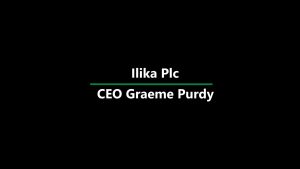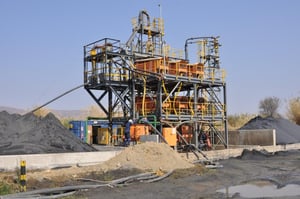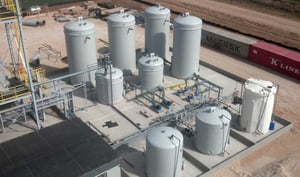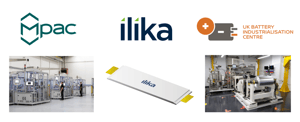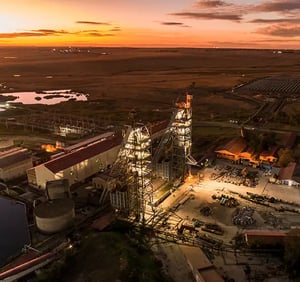BlackRock Income and Growth Investment Trust plc (LON:BRIG) has announced its half yearly financial report for the six months ended 30 April 2022.
For more information on the BlackRock Income and Growth Investment Trust and how to access the opportunities resented by the income and growth sector, please visit: www.blackrock.com/uk/brig
PERFORMANCE RECORD
| As at 30 April 2022 | As at 31 October 2021 | Change % | |
| Net assets (£’000)1 | 44,028 | 43,468 | +1.3 |
| Net asset value per ordinary share (pence) | 207.67 | 203.13 | +2.2 |
| Ordinary share price (mid-market) (pence) | 187.00 | 191.00 | -2.1 |
| Discount to net asset value2 | 10.0% | 6.0% | |
| FTSE All-Share Index | 8430.58 | 8173.30 | +3.1 |
| ————— | ————— | ————— | |
| Performance (with dividends reinvested) | |||
| Net asset value per share2 | 4.5% | 30.4% | |
| Ordinary share price2 | 0.3% | 22.2% | |
| FTSE All-Share Index | 3.1% | 35.4% | |
| ========= | ========= |
| For the six months ended 30 April 2022 | For the six months ended 30 April 2021 | Change % | |
| Revenue | |||
| Net profit after taxation (£’000) | 752 | 699 | +7.6 |
| Revenue earnings per ordinary share (pence)3 | 3.53 | 3.15 | +12.1 |
| ————— | ————— | ————— | |
| Dividends (pence) | |||
| Interim | 2.60 | 2.60 | – |
| ========= | ========= | ========= |
1 The change in net assets reflects the market movements during the period, the purchase of the Company’s own shares and dividends paid.
2 Alternative Performance Measures, see Glossary in the Half Yearly Financial Report.
3 Further details are given in the Glossary in the Half Yearly Financial Report.
Sources: BlackRock and Datastream.
CHAIRMAN’S STATEMENT
Dear Shareholder
OVERVIEW
Recent reports to shareholders were, inevitably, dominated by the COVID-19 pandemic and its inpacts on markets and economies. Direct impacts, lockdowns and the like have reduced over the recent months, although the receding pandemic has left behind it a number of related supply constraints, causing inflation to rise sharply as demand for goods outstripped supply as economic activity restarted. These effects were then compounded by Russia’s invasion of Ukraine and the resulting humanitarian crisis. Market volatility spiked and sentiment has been firmly orientated towards fear not greed, with market participants reducing exposure and seeking safe havens. The West’s response to Russia’s invasion has been decisive, applying unprecedented sanctions on Russian companies and financial institutions, freezing assets and even the announcement by the UK and the US of a total ban on the import of Russian oil and gas.
Although many would argue these severe actions have been entirely appropriate, they have not been without significant cost to Western economies. The resulting energy supply shock has seen energy prices skyrocket and this, coupled with the existing post-COVID-19 supply constraints mentioned above, has pushed inflation to levels not seen in decades in the UK, hitting a 40 year high of 9.1% in May 2022. This has left central banks walking a delicate tightrope act between intervening to address soaring inflation, while running the risk of curtailing economic growth. The Bank of England raised interest rates by 0.25 percentage points to 1% in May 2022 and by a further 0.25 percentage points in June 2022, with further rate hikes likely later this year, which along with other policy tightening, points to a likely drop in the rate of inflation over the next half year or so. Looking into the future though, equity markets have given back much of the gains made from the economic restart, reflecting the anticipation of further interest rate hikes, the rapidly rising cost of living and lower consumer spending, higher operational costs for companies as the price of commodities and energy rise and, ultimately, lower overall levels of growth for UK public companies.
Against the turmoil described above, I am pleased to report that our portfolio has been resilient, outperforming many of its sector peers and the benchmark return during the period. In addition, it is also positive to see that the revenue generated by our investment portfolio has risen versus the prior year, despite the challenges during the period. As you will read in the Investment Manager’s report which follows, our portfolio saw strong performance from our exposure to commodities and energy. Our financial holdings also performed well as interest rates rose, and our portfolio managers have added several new holdings which are well placed to benefit from rising energy prices and the UK Government’s focus on energy security.
PERFORMANCE
During the period, the Company’s net asset value per share (NAV) returned 4.5%, compared with the Company’s benchmark, the FTSE All-Share Index (total return), which returned 3.1%. The Company’s share price returned 0.3% (all percentages in Sterling with dividends reinvested).
Subsequent to the period end and as at 20 June 2022, the net asset value per share of the Company has decreased by 6.5% from 207.67 pence per share to 194.27 pence per share and the Company’s share price has fallen by 5.3% from 187.00 pence to 177.00 pence per share. The Company’s Benchmark Index has decreased by 5.6% over the same period.
Further information on the significant components of overall performance and the changes to portfolio composition are set out in the Investment Manager’s Report below.
REVENUE PROFIT AND DIVIDENDS
Revenue profit for the period was 3.53 pence per share (six months to 30 April 2021: 3.15 pence per share), an increase of 12.1% year-on-year. The Board is pleased to declare an interim dividend of 2.60 pence per share (2021: 2.60 pence per share). This dividend will be paid on 1 September 2022 to shareholders on the Company’s register at the close of business on 22 July 2022 (the ex-dividend date is 21 July 2022).
I am pleased to report that our interim dividend is fully covered by the revenue generated during the period. After the payment of this year’s interim dividend, the Company will have approximately one year’s dividend cover in revenue reserves.
SHARE CAPITAL
The Directors recognise the importance to investors that the Company’s share price should not trade at a significant discount to NAV, and therefore, in normal market conditions, may use the Company’s share buy back, sale of shares from treasury and share issuance powers to seek to ensure that the share price does not differ excessively from the underlying NAV.
Buying back shares at a discount is accretive to NAV and can help narrow the discount to NAV at which the Company’s shares trade. It can also help to provide additional liquidity. During the period the Company’s shares traded at an average discount of 8.9% and ended the period at 10.0%. At the close of business on 20 June 2022 the discount had narrowed to 8.9%.
A total of 198,206 ordinary shares were bought back and cancelled during the period at an average price of 183.65 pence and for a total consideration of £364,000. No shares were issued or sold from treasury during the period under review. As at 20 June 2022, 32.3% of the Company’s issued ordinary share capital is held in treasury and may be issued to satisfy any demand for the Company’s shares that may arise.
GEARING
The Company operates a flexible gearing policy which depends on prevailing conditions and the outlook for the market. Gearing is subject to a maximum level of 20% of net assets at the time of investment. The Company reduced levels of gearing during the period under review and at 30 April 2022 the Company had net gearing of 1.4%. Gearing levels and sources of funding are reviewed regularly to ensure that the Company has access to the most competitive borrowing rates available to it. The Company currently has a two-year unsecured Sterling revolving credit facility of £4,000,000 with ING Bank (Luxembourg) S.A., which is fully drawn down and is scheduled to mature in November 2023.
SHAREHOLDER COMMUNICATION
The Board appreciates how important access to regular information is to our shareholders. To supplement our Company website, we now offer shareholders the ability to sign up to the Trust Matters newsletter which includes information on the Company as well as news, views and insights. Further information on how to sign up is included on the inside cover of the Half Yearly Financial Report.
OUTLOOK
As you will read in their report which follows below, your investment managers continue to seek out companies that can generate strong, consistent cash flow, from robust business models which have favourable industry characteristics or scope for management driven self-help. They are focused on bottom-up stock selection and are emboldened by the attractive stock-specific opportunities on offer.
Given the ongoing market volatility our portfolio managers continue to apply prudent balance to the portfolio which has resulted in resilience and the protection of shareholder capital during these most challenging times. However, they also continue to seek exposure to macro trends and growth through those companies best placed to thrive in the current environment, whilst applying a degree of caution as the powerful macroeconomic drivers described above play out through the remainder of the year and beyond.
As we move into an economic and policy environment which is more than usually changeable, your Board remains fully supportive of our portfolio managers’ approach and to their aim of positioning the portfolio to deliver on the Company’s investment objective.
GRAEME PROUDFOOT
Chairman
22 June 2022
INVESTMENT MANAGER’S REPORT
PERFORMANCE
For the six month period since 31 October 2021, the Company’s NAV returned 4.5%, outperforming its benchmark, the FTSE All-Share Index (the Benchmark Index), which returned 3.1% over the same period (all percentages in Sterling with dividends reinvested).
INVESTMENT APPROACH
In assembling the Company’s portfolio, we adopt a concentrated investment approach to ensure that our best ideas contribute significantly to returns. We believe that it is the role of the portfolio overall to generate an attractive and growing yield alongside capital growth rather than every individual company within the portfolio. This gives the Company increased flexibility to invest where returns are most attractive. This approach results in a portfolio which differs substantially from the index and in any individual year the returns will vary, sometimes significantly from those of the index. The foundation of the portfolio, approximately 70%, is in high free cash flow companies that can sustain cash generation and pay a growing dividend whilst aiming to deliver a double-digit total return. Additionally, we look to identify and invest 20% of the portfolio in ‘growth’ companies that have significant barriers to entry and scalable business models that enable them to grow consistently. We also look for turnaround companies, at around 10% of portfolio value, which represent those companies that are out of favour with the market offering attractive recovery potential.
MARKET REVIEW
The Benchmark Index rose 3.1% over the six months to 30 April 2022 with Oil & Gas, Utilities and Basic Materials as top outperformers. The Benchmark Index was a notable outperformer versus other developed markets indices where a number of emerging and strengthening headwinds served to put pressure on risk assets globally. These headwinds include the Omicron COVID-19 variant, Russia’s invasion of Ukraine as well as a general increase in geopolitical tensions, rising inflation, weakening consumer sentiment and record high energy prices.
The Omicron variant created a ripple effect in developed markets early in the period and although its impact faded as 2022 has progressed, it continues to disrupt economic activity, most notably in China where stringent lockdowns are still enforced affecting global supply chains.
Prior to Russia’s invasion of Ukraine, markets had been impacted by the steep rise in bond yields as investors rapidly repriced the scale and speed of interest rate rises in response to high and persistent inflation. Supply constraints have been widespread with the shortage of semiconductors perhaps the highest profile.
The war has only served to exacerbate those inflationary concerns with key commodities across energy and agricultural markets rising sharply in price; security of energy supply becoming a key focus as countries seek to reduce their dependence on Russia. Market performance was dominated by the strength in commodities prices which benefitted the Mining and Oil & Gas sectors. These are relatively large weights in the Benchmark Index contributing to its relative resilience over this period. Defensive sectors, such as Tobacco and Pharmaceuticals, also benefitted from greater economic uncertainty. Meanwhile, long-duration assets were negatively impacted by rising interest rates which reduce the present value of their growth.
CONTRIBUTORS TO AND DETRACTORS FROM PERFORMANCE
Positive contributors to performance included stock selection in the Consumer Services, Basic Materials and Consumer Goods sectors and the overweight positioning to the Health Care sector.
The mining sector performed strongly during the period reflecting strength in commodity markets and continued capital discipline from the miners as demonstrated by further large shareholder returns. As a result, the holdings in Rio Tinto and BHP were significant contributors to the returns of the Company during the period.
Standard Chartered was also a top contributor to performance benefitting from increases in interest rates and a return to revenue growth. Mastercard also contributed to performance after the company reported solid results with strong payment volumes and an encouraging acceleration in cross-border volume linked to increased travel. This supports our thesis that growth will accelerate as the continued structural shift towards digital payments is boosted by a normalisation in consumer activity post COVID-19.
As economic uncertainty boosted defensive holdings, British American Tobacco and nutrition ingredients business, Tate & Lyle rose and performed well during the period. Other positive contributors to performance during the period included education business, Pearson which received a takeover approach even though the bid has subsequently fallen away, and Drax Group, the power generator, benefitting from the disruption in oil and gas markets. Both Tate & Lyle and Drax Group were recent additions to the Company having been purchased during the second half of 2021.
Detractors from performance included the underweight positioning to Oil & Gas given the strength in the oil price and the sector. Holdings in the Industrials sector also detracted, impacted by the rotation away from growth stocks, concerns regarding the risk of supply chain shocks and as recessionary fears emerged. We remain confident that we have invested in franchises that have built durable competitive advantages, are cash generative and boast strong balance sheets that are well placed to navigate this challenging operating environment.
Notable detractors included Hays and Moonpig Group which reflected concerns of a deterioration in the economic backdrop and consumer weakness given rising inflationary pressures. Taylor Wimpey was impacted by fears of further costs associated with the cladding removal bill as well as the impact of rising inflation and interest rates on their customers and their profitability. Adobe Systems also fell despite robust operational performance given the increase in the interest rates which has reduced the premium at which high growth, technology companies are valued.
TRANSACTIONS
We purchased a new holding in BT Group which is building out the UK’s national fibre network, targeting more than 25 million homes, providing consumers and businesses with access to high-speed internet. We believe that the regulatory landscape for the UK telecom industry is improving and that the market participants are behaving more rationally. We are seeing price rises of Consumer Prices Index (CPI) +4%, with limited backlash so far and all operators are following suit. The company has the ability to put through in-contract price rises in their contract wording, limiting any sticker shock. The average telecoms bill represents 0.4% of UK household’s bills such that the currently expected 9% price rise equates to a c.£50 increase in the annual bill. There is a high drop through from these price rises to the company’s profits and cash flow, while the capex investment phase around fibre slows in around 4 years, at which point we expect a meaningful uplift in free cash flow generation. We also purchased a new holding in Centrica, the British gas company, as we view it as a beneficiary of rising energy costs and of the increased focus on security of supply.
During the period we continued to reduce our Consumer exposure by selling Next and Tesco and reduced the US exposure with the sale of Analog Devices. We sold our holding in Oxford Nanopore following the strong share price performance post Initial Public Offering. We also sold the position in Smiths Group. After the successful sale of the company’s medical division and recent strength in the share price, the investment case required an acceleration in organic growth which we believe may prove more challenging given the difficult economic backdrop. We also materially reduced our position in BP Group given its large stake in Rosneft, continuing to favour a larger position in Shell.
Ferguson’s strong logistics enabled the company to thrive during this period of disrupted supply chains while high commodity prices boosted revenues and margins. The strong share price combined with our concern over the sustainability of this performance prompted us to sell the holding. We used some of the proceeds of the Ferguson sale to purchase a new holding in Ashtead Group, the US focused equipment rental company offering attractive structural growth from continued outsourcing trends in this fragmented industry following recent share price weakness.
GEARING
Our general approach to gearing is that we aim to run the Company with a modest and consistent level of gearing to enhance income generation and capital growth; accordingly, the Company is typically 5-10% geared, however, at 30 April 2022, the Company had employed net gearing of 1.4% to reflect our more cautious views on markets.
OUTLOOK
We are conscious that, at the time of writing, there is a significant conflict and human suffering. Whilst we continue to reference the investment implications of this, we recognise there are also tremendous implications for humanity. The Russian invasion of Ukraine has contributed not just to the volatility of 2022, but also to the range of outcomes. The backdrop for global equities therefore, in our view, is mixed. Although demand remains strong, the outlook for corporate revenue and earnings growth is likely to worsen over the course of 2022 as the potential negative jaws of rising oil prices and rates raise the spectre once again of stagflation. It is still likely that despite the emerging cost of living crisis, government stimulus continues to be retracted, and monetary policy is tightened in the face of more persistent inflationary pressures. It will be incredibly important to focus on companies with strong, competitive positions that can deliver in this environment and that trade at attractive valuations.
Central banks, universally across the developed world, have entered 2022 in a far more hawkish manner and as a result, market expectations for higher rates and faster quantitative tightening have risen considerably. Time will tell whether the conflict impacts the growth outlook and therefore the hawkishness of central banks. It is also more likely we will see increasingly divergent regional monetary approaches with the US being somewhat more insulated from the impact of the conflict, than for example, Europe. We still do not know whether the current inflationary trends are temporary or structural. Within this calculation one must consider the impact from the significant COVID-19 stimulus, the unwinding of extreme COVID-19 behaviours, a more structural shift in the cost of labour and the impact on costs from the decarbonisation agenda or, indeed, a combination of the above. It is difficult to have a high degree of confidence in the outcome, but we would note, given the uncertainty, there is a rising risk of a policy mistake; either being too late to tighten and/or tightening too hard. We expect this, and the geopolitical ramifications of the Ukraine war, to be the prevailing debate of 2022 and beyond.
The strain on supply chains, caused by strong economic activity overwhelming COVID-19 afflicted capacity and restricted labour availability, will continue to provide inflationary pressures which can squeeze companies’ margins. As a reminder, we continue to concentrate the portfolio on businesses with pricing power and durable, competitive advantages as we see these as best placed to protect margins and returns over the medium and long term. However, a notable feature of our conversations with a wide range of corporates in 2021 was the ease with which they were able to pass on cost increases and protect or expand margins. Management teams have pointed to robust demand, prioritisation of security of supply as well as well-publicised supply chain disruption and cost pressures. However, we believe that as some of the transitory inflationary pressures start to fade (e.g., commodity prices, supply chain disruption) then pricing conversations will become more challenging. We are also increasingly focused on wage inflation which may be more structural and yet, in our experience, harder to pass on. Corporates have already pointed to wages picking up, the introduction of bonuses and growing pressure on employee retention rates as competition for labour intensifies. We therefore believe that employee retention will be an important differentiator in 2022 given the productivity benefits of a stable workforce as labour markets tighten further.
The UK stock market has started the year far better than any other developed market indices, benefitting from a far lower, and thus more attractive, starting valuation. The Benchmark Index has benefitted from the lack of a widespread re-rating seen in many other markets as well as its relatively high exposure to commodities. We continue to see appetite to acquire great market positions, real assets and/or unlevered free cash flow as highlighted by takeover approaches for two portfolio holdings – Oxford Instruments and Pearson. While most companies are paying dividends once more, we note the large contribution from special dividends that may not persist. That said, as the highest dividend yielding market in the developed world, we see the fundamental valuation of the UK as attractive. We also view the outlook for ordinary dividends for the UK market with optimism as most companies have emerged from the COVID-19 crisis with appropriate dividend policies.
We continue to have conviction in cash generative companies with durable competitive advantages, exceptional management teams and underappreciated growth potential. At present, whilst we are excited by the attractive stock-specific opportunities on offer, we continue to approach the year with balance in the portfolio.
ADAM AVIGDORI AND DAVID GOLDMAN
BLACKROCK INVESTMENT MANAGEMENT (UK) LIMITED
22 June 2022
Ten largest investments*
1 = AstraZeneca (2021: 1st)
Sector: Pharmaceuticals & Biotechnology
Market value: £3,637,000
Percentage of portfolio: 8.2% (2021: 7.2%)
AstraZeneca is an Anglo-Swedish multinational pharmaceutical group with its headquarters in the UK. It is a science-led biopharmaceutical business with a portfolio of products for major disease areas including cancer, cardiovascular infection, neuroscience and respiration.
2 + Shell (2021: 3rd)
Sector: Oil & Gas Producers
Market value: £3,161,000
Percentage of portfolio: 7.1% (2021: 4.7%)
Shell is a global oil and gas group. The group operates in both Upstream and Downstream industries. The Upstream division is engaged in searching for and recovering crude oil and natural gas, the liquefaction and transportation of gas. The Downstream division is engaged in manufacturing, distribution and marketing activities for oil products and chemicals.
3 + Rio Tinto (2021: 7th)
Sector: Mining
Market value: £2,408,000
Percentage of portfolio: 5.4% (2021: 3.7%)
Rio Tinto is a metals and mining group operating in about 36 countries around the world, producing iron ore, copper, diamonds, gold and uranium.
4 – RELX (2021: 2nd)
Sector: Media
Market value: £2,394,000
Percentage of portfolio: 5.4% (2021: 5.2%)
RELX is a global provider of professional information solutions that includes publication of scientific, medical, technical and legal journals. It also has the world’s leading exhibitions, conference and events business.
5 – Reckitt Benckiser (2021: 4th)
Sector: Household Goods & Home Construction
Market value: £2,085,000
Percentage of portfolio: 4.7% (2021: 4.5%)
Reckitt Benckiser is a global leader in consumer health, hygiene and home products. Its products are sold in 200 countries and its 19 most profitable brands are responsible for 70% of net revenues.
6 + British American Tobacco (2021: 8th)
Sector: Tobacco
Market value: £1,653,000
Percentage of portfolio: 3.7% (2021: 3.7%)
British American Tobacco is one of the world’s leading tobacco groups, with more than 200 brands in the portfolio selling in approximately 180 markets worldwide.
7 – 3i Group (2021: 6th)
Sector: Financial Services
Market value: £1,534,000
Percentage of portfolio: 3.4% (2021: 3.8%)
3i Group is a leading international investor focused on mid-market Private Equity and Infrastructure. 3i Group invests in mid-market buyouts, growth capital and infrastructure. Sectors invested in are business and financial services, consumer, industrials and energy and health care.
8 + Phoenix Group (2021: 21st)
Sector: Life Insurance
Market value: £1,504,000
Percentage of portfolio: 3.4% (2021: 2.1%)
Phoenix Group is one of the largest providers of insurance services in the United Kingdom. The group offers a broad range of pensions and savings products to support people across all stages of the savings life cycle.
9 = Electrocomponents (2021: 9th)
Sector: Support Services
Market value: £1,480,000
Percentage of portfolio: 3.3% (2021: 3.4%)
Electrocomponents is a British-based distributor of industrial and electronics products. Operating in 80 countries, the group is a global omni-channel provider of product and service solutions for designers, builders and maintainers of industrial equipment and operations.
10 + Standard Chartered (2021: 12th)
Sector: Banks
Market value: £1,409,000
Percentage of portfolio: 3.2% (2021: 3.1%)
Standard Chartered is a British multinational banking and financial services group headquartered in London. It operates a network of more than 1,200 branches and outlets across more than 70 countries; working across some of the world’s most dynamic markets including Asia, Africa and the Middle East.
* The following symbols shown after the portfolio ranking number indicate the change in the relative ranking of the position in the portfolio compared to its ranking as at 31 October 2021: + indicates an increase, – indicates a decrease and = indicates no change.
All percentages reflect the value of the holding as a percentage of total investments as at 30 April 2022.
Together, the ten largest investments represent 47.8% of total investments (31 October 2021: 43.5%).
Distribution of investments as at 30 April 2022
Analysis of portfolio by sector
| % of investments by market value | Benchmark Index | |
| Support Services | 13.8 | 4.3 |
| Pharmaceuticals & Biotechnology | 9.7 | 10.9 |
| Household Goods & Home Construction | 8.1 | 1.2 |
| Oil & Gas Producers | 8.0 | 10.3 |
| Media | 7.7 | 3.2 |
| Mining | 7.2 | 7.6 |
| Life Insurance | 6.4 | 2.6 |
| Financial Services | 5.4 | 4.1 |
| Banks | 4.9 | 7.9 |
| Non-Life Insurance | 4.0 | 0.8 |
| Tobacco | 3.7 | 3.8 |
| Health Care Equipment & Services | 2.8 | 0.7 |
| Food Producers | 2.7 | 0.6 |
| Electronic & Electrical Equipment | 2.7 | 0.9 |
| Travel & Leisure | 2.6 | 2.8 |
| General Retailers | 1.7 | 2.8 |
| Personal Goods | 1.7 | 0.4 |
| Fixed Line Telecommunications | 1.5 | 2.0 |
| Electricity | 1.4 | 1.0 |
| Gas, Water & Multiutilities | 1.3 | 2.7 |
| Software & Computer Services | 1.0 | 0.0 |
| Industrial Engineering | 0.9 | 0.6 |
| Real Estate Investment Trusts | 0.8 | 2.7 |
Sources: BlackRock and Datastream.
Investment size
| Number of investments | % of investments by market value | |
| <£1m | 25 | 30.7 |
| £1m to £2m | 13 | 38.5 |
| £2m to £3m | 3 | 15.5 |
| £3m to £4m | 2 | 15.3 |
Source: BlackRock.
Investments as at 30 April 2022
| Market value £’000 | % of investments | |
| Support Services | ||
| Electrocomponents | 1,480 | 3.3 |
| Rentokil Initial | 1,287 | 2.9 |
| Hays | 1,220 | 2.8 |
| Mastercard1 | 1,158 | 2.6 |
| Ashtead Group | 593 | 1.3 |
| Grafton Group | 409 | 0.9 |
| ————— | ————— | |
| 6,147 | 13.8 | |
| ========= | ========= | |
| Pharmaceuticals & Biotechnology | ||
| AstraZeneca | 3,637 | 8.2 |
| Sanofi1 | 680 | 1.5 |
| ————— | ————— | |
| 4,317 | 9.7 | |
| ========= | ========= | |
| Household Goods & Home Construction | ||
| Reckitt Benckiser | 2,085 | 4.7 |
| Taylor Wimpey | 959 | 2.1 |
| Berkeley Group | 578 | 1.3 |
| ————— | ————— | |
| 3,622 | 8.1 | |
| ========= | ========= | |
| Oil & Gas Producers | ||
| Shell | 3,161 | 7.1 |
| BP Group | 404 | 0.9 |
| ————— | ————— | |
| 3,565 | 8.0 | |
| ========= | ========= | |
| Media | ||
| RELX | 2,394 | 5.4 |
| Pearson | 1,041 | 2.3 |
| ————— | ————— | |
| 3,435 | 7.7 | |
| ========= | ========= | |
| Mining | ||
| Rio Tinto | 2,408 | 5.4 |
| BHP | 809 | 1.8 |
| ————— | ————— | |
| 3,217 | 7.2 | |
| ========= | ========= | |
| Life Insurance | ||
| Phoenix Group | 1,504 | 3.4 |
| Legal & General Group | 1,340 | 3.0 |
| ————— | ————— | |
| 2,844 | 6.4 | |
| ========= | ========= | |
| Financial Services | ||
| 3i Group | 1,534 | 3.4 |
| Premier Asset Management Group | 526 | 1.2 |
| IntegraFin | 353 | 0.8 |
| ————— | ————— | |
| 2,413 | 5.4 | |
| ========= | ========= | |
| Banks | ||
| Standard Chartered | 1,409 | 3.2 |
| Lloyds Banking Group | 778 | 1.7 |
| ————— | ————— | |
| 2,187 | 4.9 | |
| ========= | ========= | |
| Non-Life Insurance | ||
| Direct Line Group | 1,088 | 2.4 |
| Hiscox | 728 | 1.6 |
| ————— | ————— | |
| 1,816 | 4.0 | |
| ========= | ========= | |
| Tobacco | ||
| British American Tobacco | 1,653 | 3.7 |
| ————— | ————— | |
| 1,653 | 3.7 | |
| ========= | ========= | |
| Health Care Equipment & Services | ||
| Smith & Nephew | 1,268 | 2.8 |
| ————— | ————— | |
| 1,268 | 2.8 | |
| ========= | ========= | |
| Food Producers | ||
| Tate & Lyle | 1,231 | 2.7 |
| ————— | ————— | |
| 1,231 | 2.7 | |
| ========= | ========= | |
| Electronic & Electrical Equipment | ||
| Schneider Electric1 | 613 | 1.4 |
| Oxford Instruments | 585 | 1.3 |
| ————— | ————— | |
| 1,198 | 2.7 | |
| ========= | ========= | |
| Travel & Leisure | ||
| Whitbread | 806 | 1.8 |
| Fuller Smith & Turner – A Shares | 355 | 0.8 |
| Patisserie Holdings2 | – | – |
| ————— | ————— | |
| 1,161 | 2.6 | |
| ========= | ========= | |
| General Retailers | ||
| Moonpig Group | 388 | 0.9 |
| WH Smith | 363 | 0.8 |
| ————— | ————— | |
| 751 | 1.7 | |
| ========= | ========= | |
| Personal Goods | ||
| Unilever | 745 | 1.7 |
| ————— | ————— | |
| 745 | 1.7 | |
| ========= | ========= | |
| Fixed Line Telecommunications | ||
| BT Group | 656 | 1.5 |
| ————— | ————— | |
| 656 | 1.5 | |
| ========= | ========= | |
| Electricity | ||
| Drax Group | 619 | 1.4 |
| ————— | ————— | |
| 619 | 1.4 | |
| ========= | ========= | |
| Gas, Water & Multiutilities | ||
| Centrica | 558 | 1.3 |
| ————— | ————— | |
| 558 | 1.3 | |
| ========= | ========= | |
| Software & Computer Services | ||
| Adobe Systems1 | 431 | 1.0 |
| ————— | ————— | |
| 431 | 1.0 | |
| ========= | ========= | |
| Industrial Engineering | ||
| Chart Industries1 | 425 | 0.9 |
| ————— | ————— | |
| 425 | 0.9 | |
| ========= | ========= | |
| Real Estate Investment Trusts | ||
| Big Yellow Group | 365 | 0.8 |
| ————— | ————— | |
| 365 | 0.8 | |
| ========= | ========= | |
| Total investments | 44,624 | 100.0 |
| ========= | ========= |
1 Non-UK listed investments.
2 Company under liquidation.
All investments are in ordinary shares unless otherwise stated. The total number of investments held at 30 April 2022 was 43 (31 October 2021: 48).
As at 30 April 2022, the Company did not hold any equity interests comprising more than 3% of any company’s share capital.
Interim management report and responsibility statement
The Chairman’s Statement and the Investment Manager’s Report above give details of the important events which have occurred during the period and their impact on the financial statements.
Principal risks and uncertainties
The principal risks faced by the Company can be divided into various areas as follows:
· Investment performance;
· Income/dividend;
· Gearing;
· Legal & regulatory compliance;
· Operational;
· Political;
· Market; and
· Financial.
The Board reported on the principal risks and uncertainties faced by the Company in the Annual Report and Financial Statements for the year ended 31 October 2021. A detailed explanation can be found in the Strategic Report on pages 32 to 35 and in note 16 on pages 85 to 91 of the Annual Report and Financial Statements which are available on the website maintained by BlackRock at: www.blackrock.com/uk/brig.
The ongoing COVID-19 pandemic has had a profound impact on all aspects of society in recent years. The impact of this significant event on the Company’s financial risk exposure is disclosed in note 9.
The Directors have assessed the impact of market conditions arising from the COVID-19 outbreak on the Company’s ability to meet its investment objective. Based on the latest available information, the Company continues to be managed in line with its investment objective, with no disruption to its operations.
Certain financial markets have fallen towards the end of the financial period due primarily to geo-political tensions arising from Russia’s invasion of Ukraine and the impact of the subsequent range of sanctions, regulations and other measures which impaired normal trading in Russian securities. The Board and the Investment Manager continue to monitor investment performance in line with the Company’s investment objectives, and the operations of the Company and the publication of net asset values are continuing.
In the view of the Board, other than those matters noted above, there have not been any material changes to the fundamental nature of these risks since the previous report and these principal risks and uncertainties, as summarised, are as applicable to the remaining six months of the financial year as they were to the six months under review.
Going concern
The Board remains mindful of the ongoing uncertainty surrounding the potential duration of the COVID-19 pandemic and its longer term effects on the global economy and the current heightened geo-political risk. Nevertheless, the Directors, having considered the nature and liquidity of the portfolio, the Company’s investment objective and the Company’s projected income and expenditure, are satisfied that the Company has adequate resources to continue in operational existence for the foreseeable future and is financially sound.
For this reason, they continue to adopt the going concern basis in preparing the financial statements. The Company has a portfolio of investments which are considered to be readily realisable and is able to meet all of its liabilities from its assets and income generated from these assets. Ongoing charges (calculated as a percentage of average daily net assets and using the management fee and all other operating expenses, excluding finance costs, direct transaction costs, custody transaction charges, VAT recovered, taxation and certain non-recurring items) for the year ended 31 October 2021 were approximately 1.21%.
Related party disclosure and transactions with the Manager
BlackRock Fund Managers Limited (BFM) was appointed as the Company’s Alternative Investment Fund Manager (AIFM) with effect from 2 July 2014. BFM has, with the Company’s consent, delegated certain portfolio and risk management services, and other ancillary services, to BlackRock Investment Management (UK) Limited (BIM (UK)). Both BFM and BIM (UK) are regarded as related parties under the Listing Rules. Details of the management fee payable are set out in note 3 and note 11 below. The related party transactions with the Directors are set out in note 10 below.
Directors’ responsibility statement
The Disclosure Guidance and Transparency Rules of the UK Listing Authority require the Directors to confirm their responsibilities in relation to the preparation and publication of the Interim Management Report and Financial Statements.
The Directors confirm to the best of their knowledge that:
· the condensed set of financial statements contained within the Half Yearly Financial Report has been prepared in accordance with the applicable UK Accounting Standard FRS 104 ‘Interim Financial Reporting’; and
· the Interim Management Report, together with the Chairman’s Statement and Investment Manager’s Report, include a fair review of the information required by 4.2.7R and 4.2.8R of the FCA’s Disclosure Guidance and Transparency Rules.
The Half Yearly Financial Report has not been audited or reviewed by the Company’s Auditors.
The Half Yearly Financial Report was approved by the Board on 22 June 2022 and the above responsibility statement was signed on its behalf by the Chairman.
Graeme Proudfoot
For and on behalf of the Board
22 June 2022
For more information on the BlackRock Income and Growth Investment Trust and how to access the opportunities resented by the income and growth sector, please visit: www.blackrock.com/uk/brig





